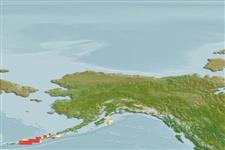Classification / Names
Nombres comunes | Sinónimos | Catalog of Fishes(Género, Especie) | ITIS | CoL | WoRMS | Cloffa
>
Perciformes/Zoarcoidei (Eelpouts and pricklebacks) >
Zoarcidae (Eelpouts) > Lycodinae
Etymology: Lycodes: Greek, lykos = wolf + Greek, suffix, oides = similar to (Ref. 45335); akuugun: Named after the Aleut name for the native inhabitants of the Islands of Four Mountains, the region where the species was discovered; noun in apposition..
Environment: milieu / climate zone / depth range / distribution range
Ecología
marino demersal; rango de profundidad 121 - 460 m (Ref. 56970). Temperate
Northeast Pacific: Aleutian Islands.
Tamaño / Peso / Age
Maturity: Lm ? range ? - ? cm
Max length : 32.4 cm SL macho / no sexado; (Ref. 56970)
Short description
Morfología | Morfometría
Radios blandos dorsales (total): 107-120; Radios blandos anales: 97 - 103; Vértebra: 113 - 120. Diagnosis: Distinguished from the majority of its congeners (46 of 61 currently recognized species) by the ventral position of the lateral line. Among species of Lycodes with a ventral lateral line, the new species is distinguished from brevipes, diapterus, hubbsi, microporus, nakamurae, nishimurai, and ocellatus by the absence of scales on the nape. It is distinguished from all remaining congeners except pectoralis and vahlii by its comparatively high vertebral count (113-120 vs. 94-113 in brunneofasciatus, caudimaculatus, frigidus, gracilis, and obscurus). It is distinguished from pectoralis and vahlii by the presence of an interorbital pore, number of anal-fin pterygiophores preceding the first haemal spine (5-7 vs. 2-4), and the color pattern (pectoralis and vahlii lack light bands on the dorsal fin, light blotches on the upper body, and the bicolor appearance of the head, body, and pectoral fin) (Ref. 56970).
The species were collected in hauls dominated by Atheresthes stomias, Theragra chalcogramma, Hippoglossus stenolepis, and Sebastes alutus; also with Lycodes diapterus and L. concolor. Bottom temperatures of collection sites ranged from 3.3-4.3 °C. Stomach contents of 2 specimens has partially digested sea urchin tests (Ref. 56970).
Life cycle and mating behavior
Madurez | Reproducción | Puesta | Huevos | Fecundidad | Larva
Stevenson, D.E. and J.W. Orr, 2006. A new species of Lycodes (Perciformes: Zoarcidae) from the Aleutian Islands. Copeia 2006(1):77-82. (Ref. 56970)
IUCN Red List Status (Ref. 130435)
Threat to humans
Harmless
Human uses
Más información
Nombres comunesSinónimosMetabolismoDespredadoresEcotoxicologíaReproducciónMadurezPuestaAgregación para la puestaFecundidadHuevosEgg development
Age/SizeCrecimientoLength-weightLength-lengthLength-frequenciesMorfometríaMorfologíaLarvaDinámica larvariaReclutamientoAbundanciaBRUVS
ReferenciasAcuiculturaPerfil de acuiculturaRazasGenéticaElectrophoresesheritabilidadEnfermedadesProcesamientoNutrientsMass conversion
ColaboradoresImágenesStamps, Coins Misc.SonidosCiguateraVelocidadTipo de nataciónSuperficie branquialOtolitosCerebrosVisión
Herramientas
Special reports
Download XML
Fuentes de Internet
Estimates based on models
Preferred temperature (Ref.
123201): 3.7 - 4.5, mean 3.9 °C (based on 6 cells).
Phylogenetic diversity index (Ref.
82804): PD
50 = 0.5000 [Uniqueness, from 0.5 = low to 2.0 = high].
Bayesian length-weight: a=0.00120 (0.00057 - 0.00252), b=3.10 (2.91 - 3.29), in cm total length, based on LWR estimates for this (Sub)family-body shape (Ref.
93245).
Nivel trófico (Ref.
69278): 3.4 ±0.5 se; based on size and trophs of closest relatives
Resiliencia (Ref.
120179): Bajo, población duplicada en un tiempo mínimo de 4.5-14 años (Preliminary K or Fecundity.).
Fishing Vulnerability (Ref.
59153): Low to moderate vulnerability (30 of 100).
